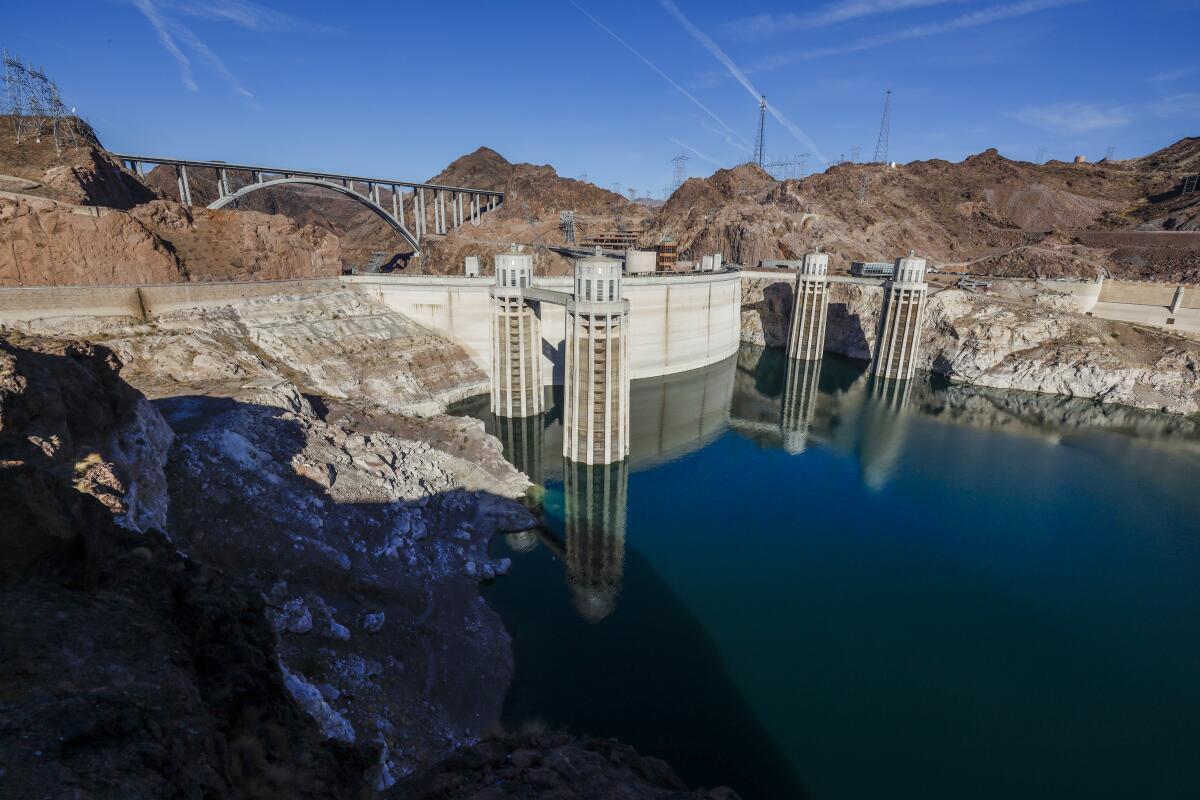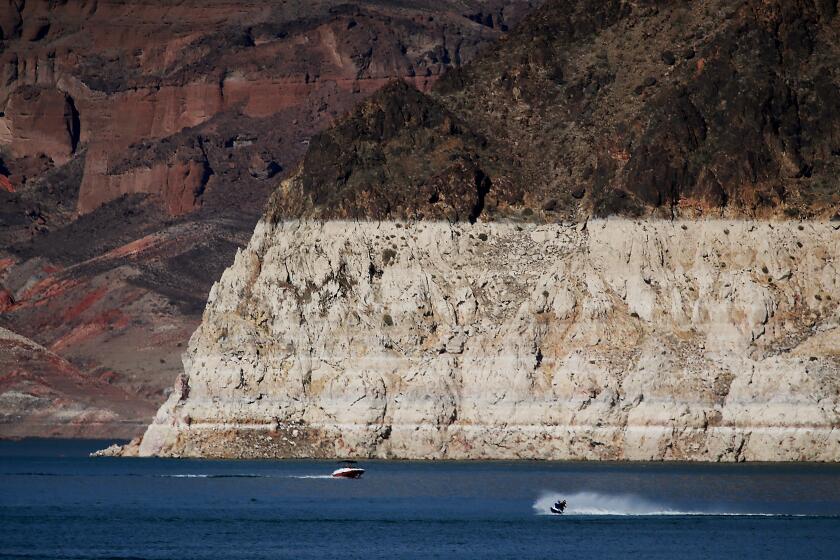Why California is so far apart from other states in Colorado River water cuts plan

- Share via
The ongoing dispute over Colorado River water comes down largely to math: How much water should each state and region lose as reservoir levels continue to decline?
California has one interpretation of how to divvy up the cuts, and six other states that depend on the river have a different formula.
A breakdown of the numbers in these two competing proposals shows the points of tension.
The proposal by six of the seven states in the Colorado River Basin would require California to shoulder a substantial part of the burden, despite its relatively higher-priority water rights. Southern California water agencies would be required to cut as much as 32% of their full water allocation if Lake Mead, the country’s largest reservoir, continues dropping toward dangerously low levels.
California’s proposal, in contrast, would hit Arizona harder as reservoir levels decline.
Exactly how much harder hasn’t been spelled out, because the proposal from California water agencies doesn’t divide the cuts between the states for the largest potential reductions.
But what’s clear in California’s proposal is that it calls for the other states, particularly Arizona, to give up more water. California’s recommendations suggest that Arizona could face some of the largest reductions at critically low reservoir levels, a major blow for a state that gets more than a third of its water from the Colorado.
The figures in the two alternatives submitted to the federal government also show significant differences in how quickly cuts would take effect in the river’s three Lower Basin states — Arizona, California and Nevada — as the reservoir’s levels continue to decline.
The proposal submitted by Arizona, Colorado, Nevada, New Mexico, Utah and Wyoming calls for requiring larger cuts sooner. Those states urged the federal government to start to account for evaporation and other water losses along the lower portion of the river — something that hasn’t been done before and that California officials argue shouldn’t be considered among the immediate options for emergency measures.
California’s proposal relies on applying cuts in a series of tiers based on Lake Mead’s levels. The first set of additional reductions, amounting to 1 million acre-feet, includes previous pledges by California water districts to reduce their take from the river by 9% starting this year. It also calls for reducing Arizona’s usage by nearly 20% and Nevada’s share by 13%.
The next set of tiered cuts, which haven’t been apportioned among the states, would begin when Lake Mead’s level reaches 1,025 feet elevation — about 27 feet below its current level. Those cuts would gradually become larger if the water level at Hoover Dam continues dropping toward 1,000 feet, a level that both proposals aim to protect.
The Colorado River supplies water to cities and farmlands from the Rocky Mountains to northern Mexico. Chronic overuse combined with 23 years of severe drought and the effects of climate change have pushed the river’s two largest reservoirs, Lakes Mead and Powell, to their lowest levels since they were filled.
If Mead continues to fall further, the dam could still release water down to a level of 895 feet. Below that point, called “dead pool,” no water would pass through Hoover Dam. Supplies would be cut off to California, Arizona and Mexico.
The growing risks of that worst-case scenario have prompted federal officials to demand the states come up with ways of preventing a catastrophic crash.
Neither proposal represents any formal agreement at this stage. The states submitted their proposals to the federal government as alternatives for officials to model as they analyze options.
The federal Bureau of Reclamation plans to consider the proposals as officials carry out a review to revise the current rules for dealing with shortages. In this process, federal officials will consider several alternatives for making cuts and managing reservoirs. They plan to release a decision this summer.
Under California’s proposal, the largest potential cuts (if Lake Mead declines below 1,025 feet elevation) could include mandatory cuts as well as voluntary reductions based on agreements among the states, said Chris Harris, executive director of California’s Colorado River Board. He said these proposed reductions are intended to protect the reservoir’s level if “we had a sequence of years of extremely dry hydrology.”
“There is uncertainty associated with how those reductions, if necessary, would be applied and to whom,” Harris said in an email. Because maintaining the viability of the water supply is vital for California, the state “would very likely do more as well” in that scenario.
California’s proposal also calls for prioritizing water for “health and safety requirements” if low reservoir levels trigger large reductions.
Arizona’s water officials disagree on this approach.
“I think it’s a proposal that probably works really well for California,” said Tom Buschatzke, director of the Arizona Department of Water Resources. “I don’t think it is robust enough, creates enough protection for the lake.”
Buschatzke and others argue that a better and more equitable approach would be to start accounting for evaporation and other water losses from the reservoirs and along the river in the Lower Basin. The proposal from Arizona and other states calls this water “infrastructure protection volumes,” or IPV, saying that immediately counting these losses, estimated at more than 1.5 million acre-feet per year among the three Lower Basin states and Mexico, would help stabilize the reservoirs.
Because California uses the single largest share of the river, that change would substantially affect the state. According to the figures outlined in the six states’ proposal, California would immediately see a cut of 18.5% in its Colorado River supplies, and could face a total reduction of 32% at critically low reservoir levels.
Accounting for these losses would mean a smaller cut of about 13% for Arizona, according to the proposal, and a roughly 6% reduction for southern Nevada.
One key difference is that under the California proposal, the largest cuts wouldn’t kick in until later. That’s “essentially a gamble on good hydrology once again helping us avoid conflict,” said John Fleck, a water researcher and writer in residence at the Utton Center at University of New Mexico’s School of Law.
“It sort of says, if we continue to have good snow, if we have a good snowpack this year, and maybe for another year or two, we can put off the reckoning of this conflict and avoid litigation,” Fleck said.
But Fleck said he disagrees with that approach.
“I just think we need to rip the Band-Aid off. We need to deal with this conflict now,” Fleck said. And what’s needed, he said, are “deep cuts now to rescue the system.”
One California water manager says Colorado River reservoirs aren’t likely to refill. Scientists agree that the region needs to plan for a drier future.
Along with the clashing points, there are commonalities in the proposals.
Both incorporate commitments for reductions under previous agreements, including cuts that are occurring this year under a 2019 deal called the Drought Contingency Plan, and reductions under a previous U.S.-Mexico agreement. The six states’ proposal also includes some potential reductions by Mexico, which would need to be negotiated.
Both sides agree on roughly how big the cuts should be to prevent a “dead pool” situation. The two proposals call for similar cuts totaling more than 3.3 million acre-feet per year as Lake Mead declines close to the critical threshold of 1,000 feet.
Reductions at that level could satisfy the Bureau of Reclamation’s goal of reducing water use throughout the seven states by 2-4 million acre-feet per year. But any decision by the federal government could also face legal challenges from the states.
Some of the region’s top water managers say they’re still hoping that a seven-state consensus might be possible.
Already in the proposals, the states have signaled they are willing to deal with substantial cuts between now and 2026 to help reservoir levels. Arizona, for example, signed on to a proposal listing potential reductions of up to nearly 44% in the state’s supply from the river.
Even as the federal government considers the competing proposals, representatives of the states and water agencies plan to hold more negotiations in private in the coming weeks.
“We still want to continue to try to work with all seven states,” Buschatzke said. “I still think the parties have a chance to find common ground.”
John Entsminger, general manager of the Southern Nevada Water Authority, said he thinks there is still “a strong commitment by all seven states to continue to work in good faith towards a solution.”
Wade Crowfoot, California’s natural resources secretary, said he expects that the gap between the water reduction numbers in the two proposals will be a starting point in the negotiations.
“When you look at the differences in volume, they’re not insurmountable,” Crowfoot said. “Everybody’s focused on trying to bridge that difference, because continued disagreement is in no one’s best interest.”
Colorado River in Crisis is a series of stories, videos and podcasts in which Los Angeles Times journalists travel throughout the river’s watershed, from the headwaters in the Rocky Mountains to the river’s dry delta in Mexico.
More to Read
Sign up for Essential California
The most important California stories and recommendations in your inbox every morning.
You may occasionally receive promotional content from the Los Angeles Times.














